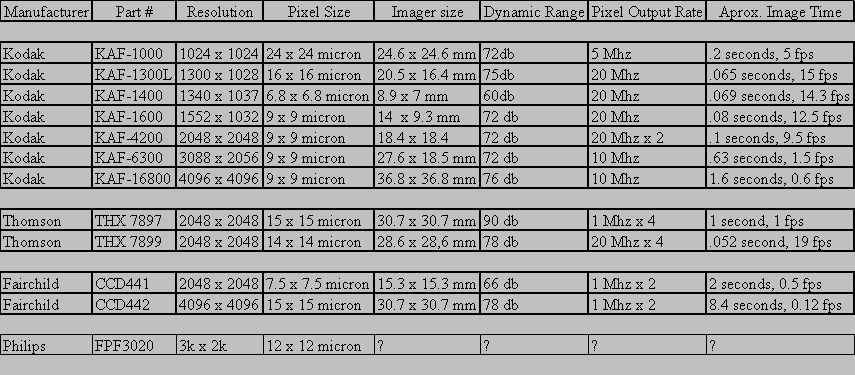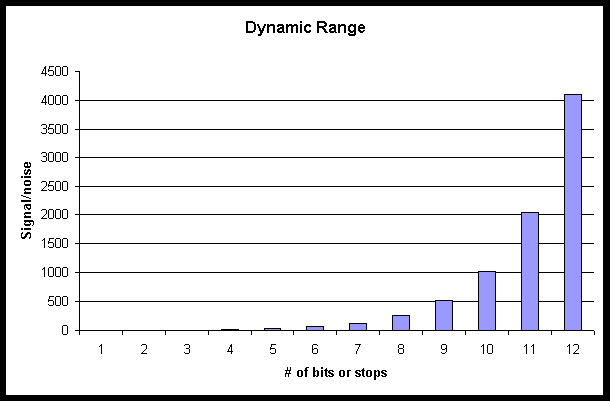Development of high resolution CCDs is limited due to the small number of users. The main market for such devices is on telescopes. Because the CCDs are used on telescopes, the emphasis is on large pixel full frame sensors with low noise that are clocked out at very slow rates.

All the CCDs in the table above are full frame. Frame transfer and interline transfer devices are at this time limited HDTV or lower resolution. We can see that Kodak, Fairchild and Philips have offerings that have sufficient resolution for our needs.
The other choice is to use some relay optics to alter the format of the lens used. This is not a bad way to do some fine adjustment to the size of the image plane. However, if the change is large as in 35 mm to 2/3" video format, the cinematographer must now adjust for stops and depth of field.
In any case we should attempt to keep the pixel size above 5 microns because lens quality will become an issue for small geometry pixels. At large pixel sizes, p>15 micron, we have the problem that the image size will fall between 35 mm and 2 x 2 format requiring substantial relay optics.
In clocking data out of a CCD, the pixels pass down through each pixel
site and are transferred to the horizontal register one line at a time.
The line is clocked out of the chip at the CCDs maximum clock rate. This
clock rate is the limiting factor, typically 1 to 20 Mhz. If we are clocking
out 3000 x 2000 pixels at 20 Mhz, each line takes 3000 x 1/(20 E6)
seconds = 150 us / line. Then 2000 lines x 150us = .3 seconds per picture
or 3.3 fps without even including vertical transfer times of 5 to 15 us/line
and exposure. Some CCD experts can manage to over clock the horizontal
output register by 2 to1, but 2 to 1 is not enough speed for our needs
and the signal to noise becomes worse during over clocking.
|
|
|
|
|
|
|
|
|
|
|
|
|
|
|
|
|
|
|
|
|
|
|
|
|
The modification required, is to increase the number of horizontal output registers to the point that we can get the image out fast enough for 24 to 48 fps. At 48 fps, we need a data rate of 48 x 3000 x 2000 = 288 Mhz horizontal clock. This means something like 30 horizontal registers running at 9.6 Mhz plus the vertical transfer time and exposure.
Needless to say we must still overcome the issues of matched output
amplifiers or multiplexing and a single amp plus the age old problem of
how digitize and store the data.
For this reason, the base speed fir digital cameras is defined as a speed which results in a given level of noise in the image (lowest light resulting in a ‘excellent’ image. Speed latitude consists of two more measurements, the lower being the saturation limit of the sensor, and the higher being the highest speed which results in an ‘acceptable’ image. Signal to noise is an acceptable image is taken as 4 times that in the excellent image.
Saturation Speed
Saturation is defined with a 1/2 stop headroom (41%) for highlights, and references an 18% reflectance test card for actual measurements. ISO saturation speed = 78 / (lux X time) where lux is measured at the sensor, and is the lowest value which will not saturate the sensor or image processing.
The Kodak KAF-6300 CCD has a saturation signal of 85,000 electrons and a quantum efficiency of 30% at 550 nm (saturation is expected to occur in green before red or blue). 0.28M photons are required for saturation. This is an energy of 1.01 E-13 (watt - sec).
(photon energy = (planks constant * speed of light) / wavelength)
At 550 nm, there are 680 lumens / watt or 680 lux / (watt - meter 2).
Photosite area is 9 microns square or 8.1 E-11 meter 2.
Lux required to saturate with a one second exposure is 0.85.
Substituting this into the ISO speed above gives a speed of 92. The
specification rounds calculated values between 80 and 100 to ISO 100.
D i s c l a i m e r s
This calculation is only approximate as the illumination specified in the standard was not used. This information along with calculations required for noise based speed are in other ISO standards which are not available to us at this time.
Other standards referenced by the speed standard are:
ISO 554 : 1974
ISO 2721 : 1982
ISO 7589 : 1984
ISO 14524
ITU-R BT.709 : 1993
Because other speed measurements are noise based, they can only be estimated without actually constructing the camera.
Both noise based ISO speeds will be higher than the saturation speed
calculated here.
Shutter Angle- For the purposes of simulating the motion blur that we associate with motion picture production, we will have to simulate or duplicate a conventional camera shutter in our SS Production Camera. If we use full frame CCDs, we will need a conventional shutter. When the data is shifted vertically through the pixel sites it will produce smear if we do not prevent light from striking the pixels with a shutter. The good thing about this is that to film people, the motion blur will be identical to existing film cameras.
The problem here is that the limiting factor in video is the monitor. A CCD is linear from its noise floor to ~97% of full well. This means that it has a very different transfer curve than film. If we consider a stop to be an increase or reduction in exposure of 2 to 1, then each 6 db of dynamic range is equal to 1 stop. That means that a CCD with 72 db of dynamic range is going to give us 12 stops. Looks great! The fact is the first stop is unusable because the noise is 50% of the signal. The second stop is unusable because the noise is 25% of the signal etc.. So the real number of useable stops depends on how much noise we can accept.

